|
|
|---|---|
Edition 74 - October 2014 Published at Quepos, Canton of Aguirre, Province of Puntarenas, Costa Rica (© Copyright 2014 - All Rights Reserved) |
A narrative version of the Golden Gringo Chronicles is now available as a trilogy of E-books in formats compatible with virtually all electronic platforms. Click on Part Number above for E-book sample downloads. (The best price is on Part 1; it's FREE)
The six-year story of the Golden Gringo Chronicles is also available as a hard copy novel of 192 pages available through Amazon and all major online retailers. ($9.95) Amazon link: GGC, the Book. (Kindle Edition available) Follow GG through the first six years of his odyssey in making the decision to retire in Costa Rica, overcoming the trials and tribulations of moving and obtaining residency there and the fun and experience of actually living in Ticoland. Ride along with the Golden Gringo as he learns about the rich, varied culture of Costa Rica, the incredible bio diversity, the charming nature of the Costa Rican people and the ease with which a sometimes clueless ex-pat can assimilate into a small southwestern town on the Pacific coast. Whether you are already a Costa Rican resident, someone contemplating a move here or just a traveler who enjoys different cultures, you will find the Golden Gringo Chronicles interesting, entertaining and informative about Costa Rica. |
Broken News
(All the News That's Fit to Reprint)
Contentious Canals
The Panama Canal recently celebrated its 100th birthday having been inaugurated on August 15, 1914 after nearly 30 years of construction and the loss of some 26,000 workers, mostly from malaria.
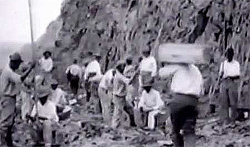 |
Panama Canal Under Construction (Cerca 1910) |
The construction of the canal was a landmark expression of the power and wealth of the United States in the early 20th century and opened up an ability to ship west coast lumber and oil to the eastern U.S. profitably, which in turn spurred construction and new businesses all across the country. The canal today continues to be important for international commerce with some 4+% of the entire commerce of the world going through it in more than 14,000 ships each year (that's an average of 38 ships per day).
But time stands still for no man or canal. The sizes of ships, particularly oil tankers and container ships has increased dramatically in the last few decades making the canal undoable for the big boys. Perhaps this fact, and maybe also the political climate, caused Nicaragua to start thinking about a new canal. Nicaragua, remember, had been the runner up when the Panama route was originally chosen. The chicanery associated with the new canal first came to light in 2010 when the Nicas invaded and seized an island called Isla Calero, at the mouth of the San Juan River and owned by Costa Rica. It also serves as part of the border between the two countries.
Not long after the aggression, President Daniel Ortega of Nicaragua announced he had an agreement to build a canal from the Caribbean side along the San Juan, across Lake Nicaragua and then exit to the Pacific near San Juan del Sur. He also announced that a Chinese company out of Kong Kong would design and build the canal at a cost of $30 billion. By 2012, the route had changed and the cost estimate rose to $40 billion. Most analysts believe the cost is likely to escalate from there and be prohibitive economically in a country with an annual national budget of only $1.5 billion. And it's hard to believe that such a level of construction cost would yield a canal competitive to Panama's.
In the meantime, the Panama Canal has been under an expansion project for several years costing $5.5 billion, which will be complete in a year and a half. This will expand its locks to accommodate 97% of the worlds's ships by 2016, The same high percentage of capability can't be said for the ports where these ships have to dock - currently only some 15 ports worldwide can handle the giants now roaming the seas. This should suggest that the Panama Canal is safe from new competition for some time.
Build your ditch at your own risk, Danny Ortega. I don't think even the Chinese, with their worldwide investment ambitions are that foolish.
For more on the Nica Canal, go here:
Danny's Ditch - Edition 48
The Chino-Nica Ditch - Edition 51
Nica Canal Update - Edition 59
Manatee New Maritime Symbol
The Chronicles has reported on the manatee population along the Caribbean coast of Costa Rica in the past (see Mega Marine Mammals).
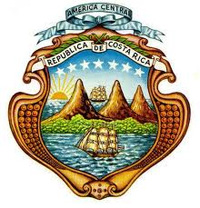 |
Current Costa Rican National Seal |
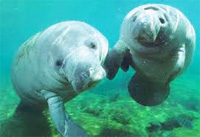 |
Manny and Mary Manatee say: "Thanks Kids" |
The kids at the Escuela Limoncito school in Limón have conducted a campaign for several years to have the maritime symbol include a manatee. On July 29 this year their efforts were recognized by the National Assembly who voted to establish the manatee as the national maritime symbol.
The legislation also gives extra protection to the manatee by way of designating them a protected species and limiting access to their habitat (like their Florida cousins, they like gobbling the sea lettuce and other greens along creeks and tide pools connected to the Caribbean).
The new design for the national symbol has not yet been released but a picture of a manatee is likely to replace at least one of the ships on the old national seal (see picture upper left).
Keep It Simple Solis
If you have ever had the chance to deal with the Costa Rican government, be it to obtain a cédula (residency card), build a home or start or run a business, you know that the level of government bureaucracy here is second to none. Evidently, our new President, Sr. Luis Guillermo Solis sees the problem also.
 |
Moses Checks With the Bureaucracy |
Solis is now a student of the KISS (Keep It Simple Silly) principle. He has decreed (there he goes again) that each public institution and ministry must appoint a high ranking employee as "Simplification Officer". To achieve his version of simplicity would require 65 Simplification Officers supposedly chosen from existing employees (?). Aren't these the ones that complicated it to begin with?
Here's a very small personal example of what they're up against. If I access my U.S. checking account on line, the procedure only requires a login name followed by a password and le voila, I have my account in front of me. For my Costa Rica account (at a government controlled bank), I first enter by cédula number (it's 12 digits in a country with 7 digits worth of people versus a SS number in the States that is nine digits in a country with nine digits worth of people).
Then I enter my password (which irritatingly is required to be reset every month - I've taken to using pass1, pass2...pass23 etc., just so I don't have to refer to a password protected file with the latest version in it). I'm then presented with a screen containing spaces for three two-digit numbers. I must refer to my "Clave Dynamica", a plastic, credit-card like creation that I must keep separately (if I lose it, I can't get into my account electronically and it's a trip to the bank for a replacement). On the Clave Dynamica is a matrix of two-digit numbers, running in columns from A to J and rows from 1 to 5. After I enter the appropriate numbers as requested by the screen to satisfy the algorithm, I can view my account. The good news is that, as cumbersome as this is, it sure beats waiting in line up to an hour at the bank, Red Cross or local pharmacy to pay your telephone, utilities or health care monthlies.
Can this kind of thinking, which is deeply imbedded in the culture, be reversed or moderated sometime before global warming drowns the Central American isthmus? Who knows.
Good luck Sr. Solis.
¡Solo Bueno!
TOP
Rumble Talk
(Shaky Happenings On or About the Pacific Rim)
Tropical Bird
of the Month |
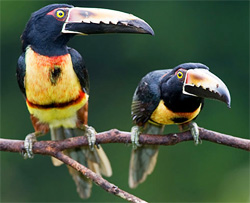 |
Aracari |
More Activity This Month
The Pacific Rim in the Americas was waking up again towards the end of September. A 4.7R hit just west of the Nicoya on September 25th but the most energetic pop came in Alaska the same day, a 6.2R about 50 miles north of Willow, AK. While a 6.2 is about 15 times as strong as a 4.7, the Alaska tremor was 61 miles deep while the CR shaker was only 9 miles deep and no significant damage was reported for either earthquake.
Mystery Eruption
The early 1800's were a politically tumultuous time in the Americas as a dozen or more countries threw off the yoke of Spanish colonialism (see History of Costa Rica - Part 2) and the first two decades also produced some mighty earthquakes and volcanic eruptions along the Pacific Rim. The most notable of these was in Tambor on the island of Sumbawa, Indonesia on April 5-10, 1815.
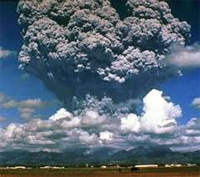 |
Tambor - Like This |
That blow sent 38 cubic miles of stuff (that's an amount of solid material about 3.5 miles long by 3.5 miles wide by 3.5 miles deep) with such force that it hit the stratosphere (43 km or 27 miles up) and visibly darkened the planet. The thunderous reports from this blast were heard on the island of Sumatra some 2,600 km or 1,600 miles away and an estimated 71,000 were killed on and about the island of Sumbawa where the volcano is located.
So much material was pumped into the atmosphere that global cooling resulted for the next 6 months to three years. The year 1816 became known by nicknames such as Eighteen-Hundred-and-Froze-to-Death or Year of the Beggar and some think it inspired literary treasures such as Byron's "Darkness" and Mary Shelley's "Frankenstein."
Some years ago, scientists found evidence in ice deposits in Greenland that the worldwide cooling problems of the 1810-1820 decade were actually preceeded by a similar eruption in northern South America, perhaps near Bogota, Columbia. Records were poor at the beginning of the 1800's, partially because of the political atmosphere, and this mystery eruption went unexplained for a long time. But painstaking research of reams of old Latin language records were scrutinized and, indeed, there were reports around 1808 that massive clouds were seen over Bogota that made the sun look like the moon. Mystery eruption explained, it was real.
One never knows when Mother Earth will take control again.
¡Pura Vida!
| Check Out Recent Earthquakes Around the World Posted by the U.S. Geodetic Survey: Today's Quakes |
|---|
A Brief History of Argentina
(Part 1 - Pre-Columbian Period, Prior to 1500)
With an impending visit to Buenos Aires planned for November, GG though it might be a good idea to study up a bit on the country. A friend who lives there was kind enough to invite the gilded one for a three week stay and then also helped him to find a very good deal on airfare. How could I say no?
This is the first in a three part series about the history and culture of Argentina and particularly Buenos Aires. Part 1 describes the geographical layout and physical attributes of the country as well as the history, during the time commonly known as pre-Columbian, i.e., in the time before the Spanish arrived. Part 2 will deal with the period of Spanish colonialization and Part 3 with the modern era as well as report some particulars learned by GG during his visit about Buenos Aires.
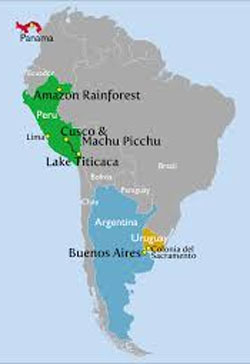 |
The history of Argentina is rich, varied and volatile, making it quite interesting. First of all, where is this place? Argentina is sizeable, about the size of Texas and Alaska combined (about one million square miles) and takes up a good part of southern South America as shown on the map to the right. It is bordered on the west and south by Chile. on the east by Uruguay and Brazil and on the north by Paraguay and Bolivia.
The federalized capital city of Buenos Aires is located in the province of the same name which is in the central and eastern part of the country on the west bank of the Rio de La Plata, a large, wide delta that drains many of the mountains of several countries and also serves as part of the border between Argentina and Uruguay. The Rio de la Plata and its tributaries are a major drainage system for the Andes and other mountains.
 |
Argentine National Flag |
The population of Argentina is about 41 million, while Buenos Aires province has about 16.5 million or 40% of the country. The city of Buenos Aires is a federal district and accounts for about 3 million in addition to the provincial numbers. The greater Buenos Aires metropolis including some of the surrounding provincial areas accounts for 13.5 million or about one third of the total population of the country.
The next three largest cities in the country are Córdoba (1.6 million), in the central part of the country about 400 km northwest of Buenos Aires, Rosario (1.3 million), about 150 km northwest of the capital and Mendoza (almost 1 million) on the far west side of the country near the border with Chile (not too far from Santiago) and nearly the same latitude as Buenos Aires. La Plata, a city just south of Buenos Aries and the capital of the Buenos Aires province ever since the city of Buenos Aires was federalized in 1980, comes in next at nearly 1 million.
The country's history is generally and typically divided into periods common to all of the Spanish speaking countries of the Americas, namely pre-Columbian, the Spanish occupation or colonialization period and the modern era. Some historians like to further divide the Argentine modern era into the period of nation-building (1810-1880) and the latest era that runs from 1880 to the present. For a similar experience of the evolution from native to Spanish to modern, but from a Costa Rican perspective, see the Chronicles articles: History of Costa Rica - A Primer, Part I, Part II, Part III.
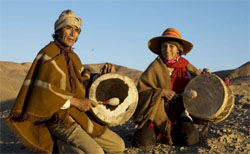 |
Modern Diaguita Natives |
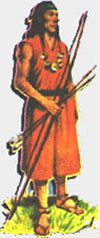 |
Daguita Cacique |
Artifacts show that mankind was present in what is now Argentina as early as 10,000 years ago. During the period leading up to the early 1800's (before the Spanish arrived) there were many nomadic native tribes that criss-crossed Argentina. But there were two tribes, who were more permanent in the Argentine region that were not nomadic but instead established farming civilizations. These were the Diaguita and the Guaraní.
The Diaguita inhabited the northwest part of the country and were similar in their culture to the Incas of the Andes. Oral legend has it that the Diaguita tribes provided a barrier and prevented the powerful Incas of Bolivia from overrunning what is now Argentina. The Diaguita lived in stone houses in simple villages and never built large cities like the Incas. Native tribes (everywhere) always had a chief or "Cacique" (cah-seek-k) who supervised the society and administered justice. The cacique and his family were treated as royalty (it's good to be king).
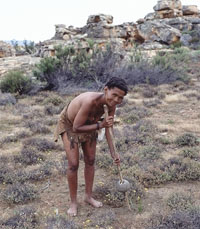 |
Daiguita Woman with "Digging Stick" |
The Diaguita lived at higher elevations perfect for growing potatoes but in their high valleys they also cultivated corn (maize), beans, and peppers. Women were responsible for tilling the land with "digging sticks" that were weighed down with stones to help break up the hard soil found in these hills. Their source of water was largely snow melt runoff which they diverted for crop use.
.jpg) |
Algarroba Pods (Carob) |
The Diaguita peoples of the northwest also hunted turkey and other small game, fished in the streams and rivers, and collected algarroba pods (carob) and prickly pears to supplement their diets. They also ran herds of llamas and alpacas as major sources of protein and for wool used in making clothing.
The other most influential tribe, the Guaraní lived to the south and east of the Diaguita, occupying what is now northeastern Argentina as well as Paraguay and southern Brazil. The topography in that region is quite different from the northwestern highlands of the Diaguita and consists mostly of river country (Rio de la Plata and its contributing rivers) and semi-tropical forests. The Guaraní also were agriculturists and planted maize, beans, sweet potatoes, peanuts, squash, and cassava. They used farming techniques that would not be in favor today, namely cutting and clearing a patch of land, burning out the undergrowth, growing their crops for several years and then moving on to virgin land to let the spent farm land replenish itself.
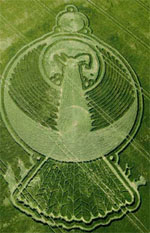 |
Drawing of a Guarani
Sacred Bird |
 |
Guaraní Kids Reenacting Days Long Gone By |
Guaraní women, like the Diaguitas, were in change of cultivating the land, growing the crops, making the meals, making the corn liquor ("chicha" - see What's-in-a-Word section below) for festivals and rituals and raising the kids while the men hunted, fished and protected the village (and probably played something like poker).
The Daiguitas lived in small stone houses that typically held one family while the Guaraní preferred large, long straw-thatched huts or lodges where as many as 50 close or extended family members might live together, especially if the hut was that of an important leader.
Caciques and important warriors were also allowed to be polygamous (again, it's good to be Cacique). Higher ranking women and wives of caciques were also allowed slaves who relieved their mistresses of the heavy burden of work put on women in general (evidently it's also good to be Mrs. Cacique).
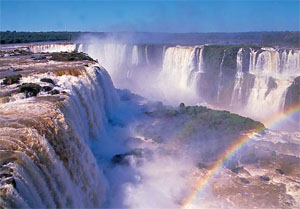 |
Iguazu (Y-Guassu) Falls, Argentina |
Natives in pre-columbian Argentina practiced animalism; that is they believed gods to be in the sun, sky, thunder, lightning, and rain as well as deifying certain animals especially birds, which held sacred meanings for the forest peoples. It's no wonder that the Guaraní also considered the Iguazu (ee-gua-zoo - natives say Y-Guassu) Falls, which were in their territory, to be a particularly sacred place.
These falls, located at the very tip of that spit of northeastern Argentina that is flanked by Uruguay, Brazil and Bolivia, are ranked as the fourth largest waterfalls in the world after the Chutes de Khone on the Mekong River - Laos, the Salto Para on the Rio Caura in Venzuela and the Kongou Falls on the Ivindo River in Gabon, Africa. (Victoria Falls on the Zambezi River in Zimbabwe ranks #7 and Niagara Falls, New York/Canada is #9).
Although GG and most historians refer to the early historical period as the Pre-Columbian period, in fact Senor Columbus never saw Argentina. On his fourth and last voyage to the new world Chris discovered Costa Rica, naming it the Rich Coast, but he never got farther south along the American continent than Bocas del Toro in Panama (see History of Costa Rica - Part II). But there were plenty of other Spanish explorers, as well as other Europeans in the 1500's roaming the waters of the world looking for riches. A few of them would come across the tip of South America, passing the Rio de la Plata.
Another Italian named Amerigo Vespucci surveyed the southern continental area and when he returned to Europe he published maps of Brazil and the region that included the future Argentina, claiming them for himself. Because of Amerigo the new continent became known as North and South America. Another Italian, Juan Díaz de Solís (no direct relation to the current president of Costa Rica), a mariner like Columbus, discovered the Rio de la Plata estuary in 1516 and briefly landed there. That was 24 years after Columbus first discovered the new world and 14 years after Chris' last voyage to the Caribbean.
The Spanish occupation would not be a good time for the natives as up to 90% of the "Indians" would perish after the arrival of the Europeans, mostly from diseases for which they had no immunity and no cure locally.
Next month: Part 2, The Columbian Period in Argentina.
¡Pura Vida!
Need a New Part for Your Dishwasher? - Print It!
(All About Additive Manufacturing and 3-D Printing)
GG came across this startling statement recently in the general press:
"... 3D printing could become a mass market product enabling consumers to save money associated with purchasing common household objects. For example, instead of going to a store to buy an object made in a factory by injection molding (such as a measuring cup or a funnel), a person might instead print it at home from a downloaded 3D model."
 |
Spock With His Tricorder (or is that Sheldon Cooper?) |
Now I don't know about you amigos but, as an old polymers and plastics manufacturing dude, this sounds a little Star-Trekish to me.
The report gave me memories of Mr. Spock firing up the old Replicator and printing everything a good Starship needs, like Phasers, Tricorders, Universal Translators, Communicator Badges for crew uniforms, Hypospray Medicine Injectors and spare parts for the Warp Drive and Transporter Device. It was fun watching all the advanced future devices being used on Enterprise I and it's generational successors. They could never be real, right?
A number of these devices are now reality or close to it, such as: 1) food (more on this below), 2) universal translator (at the moment there is one but with only 71 languages capability), 3) a university student in Ontario has designed the equivalent of a tricorder with 10 sensors (spatial, magnetic, atmospheric) and is targeting a cost under $200 so it can be used in most homes (exactly for what, yet to be determined), 4) USC students (of course) are developing virtual reality goggles that provide an experience like the Holodeck, 5) a California start-up company is producing a type of wireless communication badge for in-hospital medical personnel, hotel staff and others, 6) Apple and Google are working on advanced verbal languages in order to be able to talk to computers ("close the bay door HAL", "sorry Dave, I can't do that") and 7) NASA has suggested that a Warp Drive should be possible that will allow travel at faster than the speed of light (eat your heart out Al Einstein). NASA is not sure exactly how to do this yet but they think their current understanding of physics supports their conclusion (I wish Al was hear to check your arithmetic).
Little did we think that these Hollywood creations would become real anytime soon but, in fact, that's just about what's happening out there in manufacturing technology. The new manufacturing world, much of it based on Additive Manufacturing (essentially the same as the term 3-D Printing) in one way or another, will be incredible. Some have labeled what's going on the Third Industrial Revolution.
But just exactly how does Additive Manufacturing/3-D printing work? The concept is quite simple, even if the execution seems improbable. It all starts with a CAD (Computer Aided Design) file, something that has been used now for decades. Design something in CAD (sorta like Photoshop) and reduce it to a digital file.
CAD File ► Convert CAD file to series of cross-sectional layers ► build solid layers on 3-D printer |
When CAD files became popular and common in the seventies they were hailed as a breakthrough because they accelerated the process of designing a product and therefore getting it to market faster. The design could be done on a computer eliminating endless blueprint revisions and drafting (those of you over 50 will remember what a blueprint is). But even with CAD, it was still necessary to take a final drawing and create a prototype which included significant amount of machining for metal parts or the construction of a mold or other kind of hot process to form plastics. Besides all that, there were also significant, time-consuming, expensive post-prototype production finishing processes like sanding and polishing.
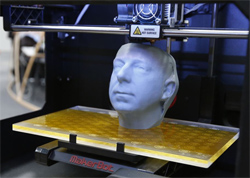 |
3-D Printing of a Bust (Not GG - Nose is too Big and Too Much Hair) |
In the new process, once the CAD drawing has been completed and "sliced" into layers digitally, 3-D printing allows you to go from drawing to prototype in a matter of hours rather than weeks or months. The printer stores the materials (plastic resins, sintered metals etc.) and the robot-like print head precisely funnels them out to the surface, one layer at a time, building up the part; hence the name "additive manufacturing". Flexibility is only limited by the number of materials used, a parameter constantly being increased in newer 3-D models.
Recent advances now conveniently provide a spectrum of colors by pre-combining pigments with the resins. Needless to say, using this process to redesign the prototype after testing is also mucho mas rapido than redoing drawings, making a new mold etc. The precision achieved in constructing (or "printing") the piece also usually eliminates the need for post-production finishing like sanding or polishing.
Video -The Future at Long John Silver's |
But they'll never be able to do this with food, right? Wrong, my duplicitous amigos. Captain Jean-Luc Picard used to say ‘Tea, Earl Gray, hot!” to his replicator and a few seconds later he would pull out the steaming cup (like the video left). That's the goal.
Gotta be an impossibility; that's really sci-fi, n'est ce pas? Not any more my fellow carbon copies. There are public and private organizations very interested in what one could do with food in the 3-D printing process.
In 2013 for example, NASA awarded $125,000 to a company to design a 3D printer capable of printing a pizza from 30-year shelf-stable foodstuffs. (I think they mean the component foodstuffs are stable in storage up to 30 years, not that the pizza will be good up to 30 years old) It may not be Papa's or Domino's delivered directly to the space station (later, man) but the idea of printing a pizza in space using electronic files of the genomes involved sounds like an interesting lunch in orbit. And the Army is studying 3-D for frontline use for meals (gives a new meaning to Meals Ready to Eat, doesn't it?).
A group of students in India released a press notice this month that they will be offering a $1,000 3-D printer for the home that will replicate chocolate bars (now we're getting there). And Nestle and Hershey are teaming up to see how they can produce chocolate products this way. Nestle, on its own, is also studying how they can customize food by 3-D printing of mixed genomes that are tailored to keep a specific person healthy. If you think GMO (Genetically Modified Organisms) were an interesting and perhaps controversial topic, hold on to your hats, it's going to get a lot more interesting.
 |
Transporter Problems, Cap'n? |
And if you can reconstruct a food on the basis of mapping its genome, how far behind are we to be able to reconstruct a human genome or a series of them? Eventually this could be the basis for a real Transporter and give a new meaning to being in two places at the same time. New York to Paris in 10 seconds. Dude, we'll have lunch at La Tour D'Argent, then get back to New York in two hours. Hopefully the trip won't upset the tummy.
The large prototype 3-D machines are still quite expensive, say $50,000 to several hundred thousand dollars. But the smaller units are becoming available for roughly the price of a large screen digital TV a few years ago. Lemme see now, if I could get a $1,000 machine that could produce meat lover's pizza daily or maybe a $200 model that will make gallo pinto for me in the morning, steaming hot and with a side of Lizano sauce...hmmmmm.
Damn, GG wishes he had gone to Starfleet Academy for a B.S. in Advanced Replicator Engineering and perhaps a Master's in Interstellar Management (MIM, the future MBA). Who was it who said that at the end of your life it's not what you did that you'll regret, it's what you didn't do.
May the Force be with you and may the geeks save us from too much cloning. Live long and prosper amigos!
¡Solo Bueno!
Mamónes
(A Curious, Beloved Fruit in Costa Rica)
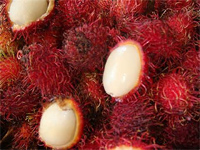 |
"Mamón Chino" (Costa Rica Mamónes) |
It started for real this July, the new season for Mamónes. You can find them most months somewhere in the markets or streets here, but during July, August and September they are prolific and there are dozens of street vendors in Quepos trying to sell them in addition to the fruterías and markets.
When GG first arrived in Q-town in late September, he came across these curious, red, hairy golf balls at the Feria, the fresh market that runs Fridays and Saturdays here. "Que es eso, amigo?" says the golden one trying to be cool; "Mamón Chino" was the response; then "Lychee" from the same man.
On my first encounter, the vendor at the Quepos Feria broke open a Mamón for me to try it. The grayish translucent flesh was gently sweet and it was easy to quickly consume the entire contents in a couple of gulps (really more like slurps), as long as one realized that there was a large nut under the flesh that needs to be spit out. Actually, some people roast the nut and, evidently, it becomes edible if prepared properly. Producers are also now finding the nut has certain fats and oils valuable for industrial uses.
Later GG would learn an alternative method for attacking the Mamón Chino was to simply bite off the top and squeeze the fruit while sucking out the contents, being careful not to choke on the nut (Mamón Chino in Costa Rican Spanish means "Chinese sucker" - see What's-in-a-Word below). Be careful with the Mamón juice however, because it is said that it will stain a dark brown color (GG can't yet confirm this from his own experience). Indigenous Malayan peoples reportedly used the juice to dye cloth brown.
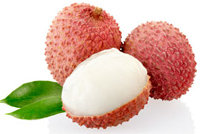 |
The Lychee |
So, with the Feria vendor calling it a Lychee, GG thought he had discovered the unrendered raw fruit that had provided his enjoyment of Lychee nuts in a dozen Chinese restaurants over the years. GG assumed that the "Lychee" had been brought here directly by the Chinese who immigrated to Costa Rica in significant numbers during the construction of the coffee and banana railroad in the late 1800's (see Choo Choo Chiquita). But as they say, "ASSUME" makes an ASS out of U and ME, because there's much more to the story that's different from GG's assumption.
It turns out that the Mamón, unlike the Lychee, doesn't even come from China, it's native to Malaysia and the tree and the fruit there both are called Rambutan (in Malay that means "hairy one"). It had been cultivated for centuries in Southeast Asia and somehow, apparently in the 20th century, the trees were somehow brought to the Americas where they easily flourished in the tropical zones like Costa Rica. It's not clear as to when they were actually introduced to Costa Rica or by whom, although it's likely they came from Asian traders in the early 1900's (if any reader has info on this, GG would appreciate knowing the origin of the Rambutan tree in Costa Rica).
It also turns out fruits of the Lychee and the Rambutan are actually a bit different, although they're both in the same generic family. The Lychee has a bumpy, red skin, but no soft spines like the Mamón. The result is that it looks more like a large raspberry than a hairy red golf ball. The Lychee fruit has a somewhat whiter flesh but the flavor of the two fruits is similar; giving a slightly acidic, slightly sweet taste similar to an unpeeled white grape. Yummers.
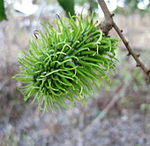 |
An Unripe Mamón |
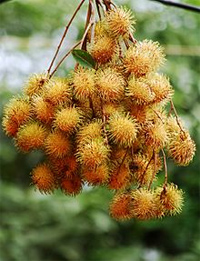 |
"Wild" or Yellow Rambutan |
Fruits like Rambutan are not climacteric, meaning they don't self-ripen by generating ethylene; no these fruits must ripen on the tree. Once harvested from the tree, they will not ripen further and are similar in this regard to citrus fruits like grapes and strawberries. Bananas, for example, are the opposite, meaning they produce and release ethylene that helps them ripen and they can ripen after harvesting (see Going Bananas).
There is also what's called a "wild" version of Mamónes or Rambutan. The Yellow Rambutan do not turn red when they ripen. You can see these also at the fresh markets, but GG has not yet taken the opportunity of sampling them.
The reputed health benefits of Mamón Chino or Rambutans are formidable, to wit (from several internet sources):
-
The fruit is high in nutrients, including riboflavin, potassium, magnesium, vitamin C, vitamin A, and zinc. Many believe a diet rich in rambutan will help lower blood pressure and prevent cancer. A 7 oz portion of fruit pulp will give 80% of the RDA of Vitamin C.
-
Rambutans are also a good source of copper. Copper deficiency can lead to anemia, ruptures in blood vessels, bone and joint problems, elevated cholesterol levels, frequent infections, and chronic fatigue. Copper is also crucial for healthy hair growth, and may help prevent hair loss (count me in), intensify hair color, and prevent premature graying of hair.
- Rambutans are an excellent source of iron.
- Mamónes have a high fiber content and are low in cholesterol and calories. Munch a dozen Mamones while your watching TV and consume less than 100 calories.
- For headache, the leaves are used as a poultice on the temples. This calms the nerves and reduces headache.
- Rambutan has antiseptic qualities and helps fight infections that invade our bodies.
- Rambutan also offers therapeutic functions. Consuming the fruit can help kill intestinal parasites and relieve symptoms of diarrhea and fever.
So why would you not eat this stuff, it tastes good and is good for you? (GG ran out and bought a bag after reading his own article)
Costa Rica has become a net exporter of Mamones. Over the last five years, 2,600 tons have been exported. That's almost six million pounds and although I don't know how many Mamones are in a pound, when you feel how light one rambutan is, the number to make 2,600 tons must be at least in the hundreds of millions of pieces of fruit.
So, don't pass up the hairy little red golf balls, munch away.
¡Pura Vida!
Travel Quote of The Month |
||
“There is no happiness for the person who does not travel. For Indra is the friend of the traveler, therefore wander!” |
What's-in-a-Word
Chicha
According to the Real Academia Española and other authoritative sources, the word chicha comes from the native american word chichab, or "chiab" which means maize or corn. However, according to other sources it comes from the Nahuatl word chichiatl, which means "fermented water"; the verb chicha meaning "to sour a drink" and the postfix -atl meaning water. (everyone likes sour water, don't you?)
But however you twist it amigos, it means a fermented drink based on corn. The common Spanish expression Ni chicha ni limonada (neither chicha nor lemonade) is roughly equivalent to the English "neither fish nor fowl".
Rambutan (mamón)
In Costa Rica it is known as mamón chino, literally translated as "Chinese sucker", due to its Asian origin and the practice of veteran mamon eaters here who bite off the tip and literally suck out the fruit.
A delectable fruit, produced with attitude and ready to eat. Rambutan (Nephelium lappaceum), pronounced, "Rum-boo-tan" ('hairy one', Malay) originated from the rainforests of the Malay Archipelago.
But be careful how you use "mamón" as it also can be a slang word with a very negative sexual connotation (exactly which one GG will leave to your creative thinking or perhaps your mental associative capabilities).
ROMEO Corner
(Retired Old Men Eating Out)
Falls Garden Cafe, Manuel Antonio
 |
Location: The Falls Hotel, Top of the mountain, across the street from "the airplane" (El Avion Restaurant) and 50 meters towards Quepos
Hours: Breakfast, Lunch and Dinner, Monday through Saturday, closed Sunday.
Parking: Limited (in season, due to the hotel) in front of the restaurant.
Contact: Tel.: 2777-1115; Email: info@fallsresortcr.com; Website: http://www.fallsgardencafe.com/
Reviewing ROMEOS: Anita M., Mary M., Lance M., Bob N.
To Review Our Rating System and Procedure, go here: R.O.M.E.O. Rating System
This is a hotel (The Falls) restaurant with a very unassuming facade. The restaurant is accessible by walking down the entrance steps, then through the lobby of the hotel to a very green, jungle-like rear area. The location of the dining room gives it almost complete protection from street noise and the room is surrounded on three sides by lush jungle vegetation.
The dining room is very tastefully decorated with drapes, indirect lighting, glass top tables and padded chairs (GG's back thanks you). The tables are simply decorated with silverware, cloth napkins and an artificial candle. The dining room overlooks a pool and there is so much greenery it's hard to see the hotel rooms which exist on both sides of the pool area. For atmosphere we give Falls Garden Cafe 4-1/2 sloths.
The menu is quite extensive and offered ample choices for the four ROMEO's to select quite different meals.
GG ordered an avocado tempura appetizer that was delicious with or without the soy dipping sauce. That was followed by a tagliatelli with seafood that included pieces of fish, mussels, shrimp and calamari rings in a velouté (alfredo) sauce - outstanding and so ample in quantity I had to send part of the pasta back after picking out all the seafood goodies. Other ROMEOS had a fish filet, a tuna sashimi and a pork medallion in a white cognac sauce. GG sampled the pork and it was tender and tasty - outstanding also. The only negative comment was that the fish filet was not quite up to the freshest standard (see *comment below). A second small negative was that, while the menu offered a fairly long list of desserts, only three were actually available. GG had the brownie with chocolate chip ice cream and chocolate drizzle (somebody's gotta do it). |
 |
|---|---|
$$$$ |
|
Value Index = 113 |
Service was quite attentive and prompt - we give 4-1/2 sloths for both quality of food and service and an overall rating of 4-1/2 sloths to the restaurant.
The bill for my tempura appetizer, tagliatelli main dish, brownie/ice cream desert, a coke and a coffee came to just over 17,000 colones or $31, after one of out long-time resident members requested a "discount for locals" and got us 10% off (did you Manuel Antonio/Quepos residents know you can do that?). That puts the Falls Garden Cafe in the upper third of restaurants in Manuel Antonio but not in the top tier, so we give it a cost rating of four $ and a Value Index of 4.5/4x100=113.
*This was a second review for this restaurant, having been first reviewed in April, 2011. At that time we gave The Falls a five sloth rating and four $ cost rating. GG suggests you read nothing significant in the slight drop in this rating (due to the difference in food rating - see above) because this time we were there in what is admittedly the slowest month of the year in Manuel Antonio (September) and we understand how difficult it is to maintain a menu during this period. Quite a few restaurants here simply close for the month.
The ROMEO group can easily recommend the Falls Garden Cafe for good food at a reasonable price.
¡Pura Vida!
don Beto de Quepos,
El Gringo Dorado Pura Vida! |
Be pithy but kind. I'm sensitive. |
|---|














